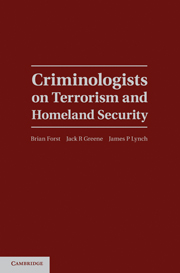Book contents
- Frontmatter
- Contents
- About the Authors
- Preface
- 1 Introduction and Overview
- PART I NATURE OF THE PROBLEM
- 2 Manifestations of Aggression
- 3 The Etiology of Terrorism
- 4 Balancing Counterterrorism Strategies
- 5 Gangs, Crime, and Terrorism
- 6 Women Terrorists
- PART II STRATEGIES FOR INTERVENTION
- PART III THINKING ABOUT TOMORROW
- Index
- References
2 - Manifestations of Aggression
Terrorism, Crime, and War
Published online by Cambridge University Press: 04 February 2011
- Frontmatter
- Contents
- About the Authors
- Preface
- 1 Introduction and Overview
- PART I NATURE OF THE PROBLEM
- 2 Manifestations of Aggression
- 3 The Etiology of Terrorism
- 4 Balancing Counterterrorism Strategies
- 5 Gangs, Crime, and Terrorism
- 6 Women Terrorists
- PART II STRATEGIES FOR INTERVENTION
- PART III THINKING ABOUT TOMORROW
- Index
- References
Summary
INTRODUCTION
One of the key challenges of our time is dealing with the threat posed by terrorism, and a key challenge when it comes to dealing with terrorism is the absence of a single, widely agreed-upon definition of the term. All definitions of terrorism include some mention of violence and the desire of those perpetrating the violence to influence the behavior of those they target, but there is limited agreement beyond these points of commonality. The lack of clarity on the meaning of the term is exemplified by Schmidt and Jongman (1988) report that a survey of academics who studied terrorism disclosed more than one hundred different definitions of it. The definitional problem extends beyond the academic realm and into the realm of governmental and international bodies, as exemplified by the following two official definitions of terrorism, by the United States and the United Nations, respectively:
“[T]errorism” means premeditated, politically motivated violence perpetrated against non-combatant targets by subnational groups or clandestine agents. (Title 22 USC)
[A]ny action … that is intended to cause death or serious bodily harm to civilians or non-combatants, when the purpose of such an act, by its nature or context, is to intimidate a population, or to compel a Government or an international organization to do or to abstain from doing any act. (Untitled Document, 2005)
Consideration of these two definitions indicates that, beyond the idea that terrorism involves violence intended to influence the behavior of others, conceptions of terrorism are often explicit about aggregates – that the violence is perpetrated by groups that seek to influence large segments of a population or specific social institutions.
- Type
- Chapter
- Information
- Criminologists on Terrorism and Homeland Security , pp. 17 - 39Publisher: Cambridge University PressPrint publication year: 2011



